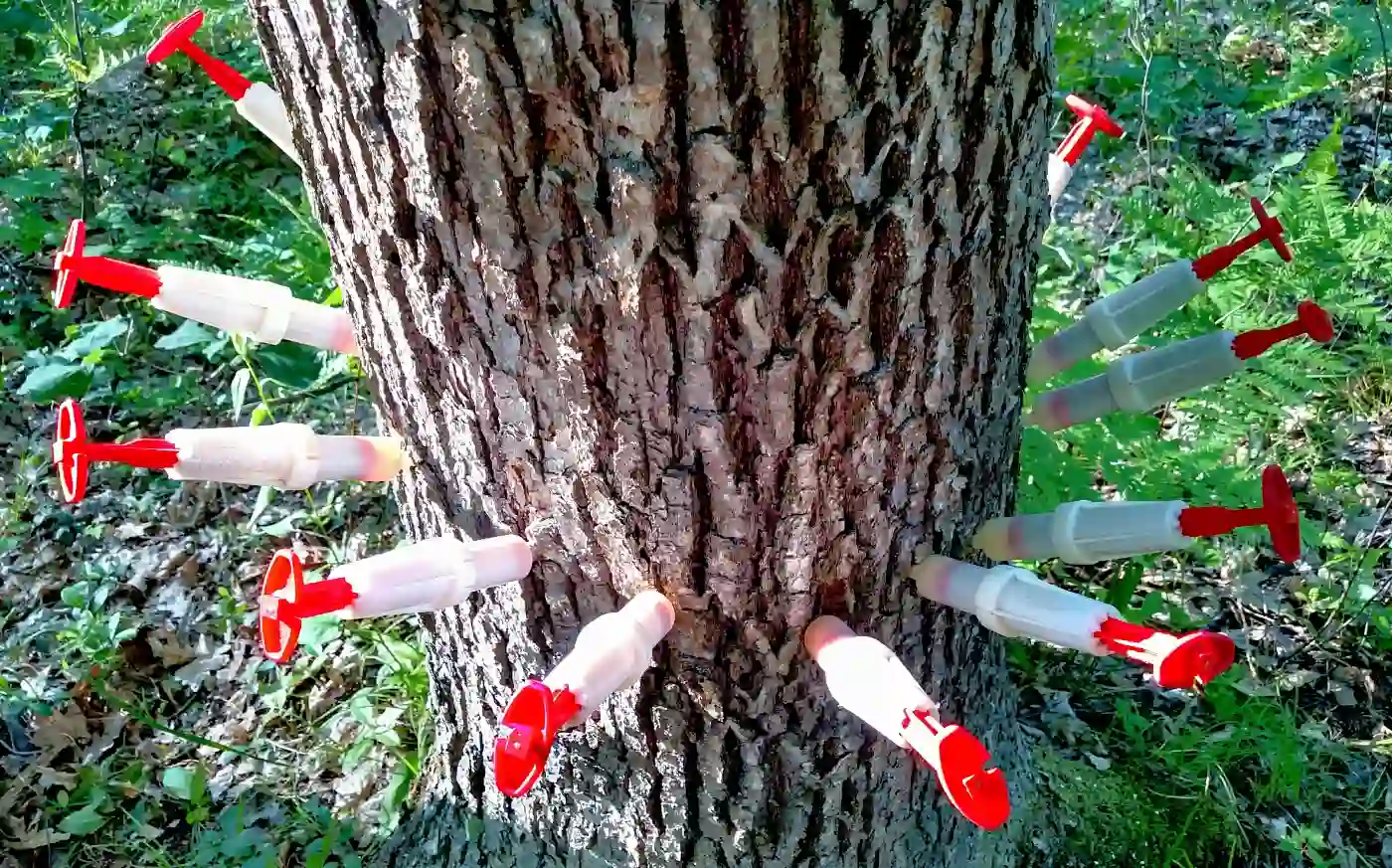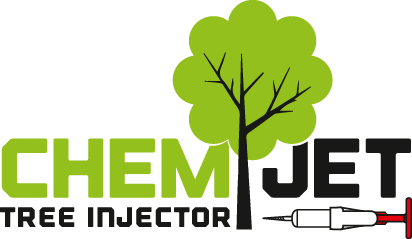Caterpillars, Beetles, Borers
Save Your Trees From Caterpillars, Beetles, Borers and other Insects
Take action to protect your trees from caterpillars, beetles, borers and other insects that feed on trees with “do it yourself” tree injection.
If you have bugs threatening to kill your trees because of defoliation or inner bark damage, you can easily treat against the chewing or sucking insects using DIY trunk injection of pesticides and reloadable Chemjet® Tree Injectors.
Direct injection of pesticides into the trunk of trees is an environmentally sound and economical way of treating for many kinds of insects that feed on trees. With injection into the circulatory system of a tree, a much lower volume of chemical is needed because it all goes into the tree, as opposed to spraying which deposits pesticide on the ground and adjacent areas for exposure to unintended receptors. Trunk injection is efficient and works fast for insect damage control.
Other Treatments and Info
- Oak Wilt Prevention and Treatment
- Save Your Trees from Oak Wilt
- Microinjection to Protect Trees From Oak Wilt
- Emerald Ash Borer Treatment
- Dutch Elm Disease
- Pine Bark Beetle Injection Treatment
- Sudden Oak Death
- Hemlock Woolly Adelgid Treatment
- Asian Longhorned Beetle Treatment
- Caterpillars, Beetles, Borers
- Orchard Crops Treatment
- Plugs for Tree Injection Holes
- Chemjet Tips and Ideas
Ideally, tree trunk injections should be conducted when the target pest insects first start to hatch or become visible on your tree. However if you miss this initial stage and observe an infestation of many bugs or start to see leaves being thinned out, there is usually still time to inject the tree and get rid of the insects. This is done using Chemjet® Tree Injectors to inject pesticides such as acephate, imidacloprid, or emamectin benzoate , into small drilled holes at several locations around the circumference of the tree. The chemical is then naturally carried by moving tree sap throughout the tree, from up to the leaves down to all of the roots, effectively killing or driving away the insects that feed on the treated tree.
There are numerous pesticides that are labeled for tree injection. Below is a brief summary of three popular injectable pesticides.

Gypsy Moth Caterpillar
Winter Moth Caterpillar
Emerald Ash Borer
- Acephate
Least expensive. Is quickly taken up throughout the tree and may start killing chewing insects in a few hours, and then degrades within three to five weeks. So it is quick to start but short acting. Often the approximate one month period of effectiveness is all that is needed to knock the bugs out of your tree that are from a single hatch or seasonal outbreak. Injectable acephate is labeled for control of: caterpillars (gypsy moth, brown tail moth, winter moth, tent worms, oak worm, many others), leaf miners, Japanese beetle, longhorned borers, white pine weevil, scale, thrips, aphids, hemlock woolly adelgid, leaf hoppers (including spotted lanternfly), emerald ash borer, bronze birch borer, two lined chestnut borer and many other chewing and sucking insects.
One injectable acephate brand is Ace-Jet. See a more complete list of pests that can be treated by acephate injection on the Ace-Jet label. There are other brands of 97% to 98% acephate available as well. Using the labeled maximum dosage for application of Ace-Jet, an example application using Chemjet Tree Injectors filled to 20 ml placed at 7.5 inch spacing intervals around the tree trunk with following chemical mixture ratio: 30 grams of Ace-Jet granules per 200 ml of water.
- Imidacloprid
Moderately expensive. Is taken up by the tree relatively slowly and may start killing chewing insects after a few days. Injected imidacloprid may continue to kill chewing bugs in the tree for up to a year with one injection. Injectable* imidacloprid is labeled for control of most of the bugs listed above. Because of the longer residual effectiveness, imidacloprid will perform better for pest problems that are ongoing throughout a longer time period, like all summer. The product Ima-Jet is commonly used, and a more complete list of pests that can be treated by imidacloprid is on the Ima-Jet 5% label. There are other brands of injectable imidacloprid available as well. Using the labeled maximum dosage for application of Ima-Jet 5%, an example application using Chemjet Tree Injector is 8-inch spacing between injection points around the circumference of the tree using Chemjet Tree Injectors filled with 20 ml of Ima-Jet 5%. Injectable imidacloprid should not be diluted with water.
*NOTE – For tree injection with imidacloprid you must use an injectable formulation, such as Ima-jet 5%. If you use a milky colored imidacloprod product such as 2F or 2L, or any dry powdered imidacloprid that you mix with water, IT WILL NOT WORK with tree injection. It contains an insoluble powder that quickly plugs up the injection hole.
- Emamectin Benzoate
Most expensive, but may be effective for insect control for up to two years with one treatment, depending on tree and insect species. Is taken up by the tree relatively slowly and may start killing chewing insects after a few days. Injectable emamectin benzoate is labeled for control of most of the bugs listed above, plus some harder to kill insects like pine bark beetles. Because of the longer residual effectiveness, emamectin benzoate will perform better for pests that will attack trees throughout a longer time period, like all summer. The products Tree-age G4 or TreeMec Inject are commonly used, and a more complete list of pests that can be treated is given on the product labels. From the Tree-age G4 label the maximum dose is just over 6-inch spacing intervals around the circumference of the tree using Chemjet Tree Injectors filled with 20 ml of Tree-age G4. Lesser doses and reduced injection point spacing could be accomplished by diluting the emamectin benzoate with water.
Please be sure to diligently follow your state pesticide application regulations and the safety and use instructions on the label of the insecticide that you select for tree injection
Tree Injection Treatment Procedure
Adapted from the Chemjet® manufacturer suggested procedure. You can inject at the root flare just above the ground, or at some point up the trunk that is easier to reach.
- Confirm with a qualified Arborist, or Biologist that this procedure is appropriate for your tree. There may be circumstances that would cause this procedure to be inappropriate. Also there is a risk that this procedure may harm your tree, or that chemical injection will be of no benefit.
- Only inject trees that have green leaves indicating there is transpiration and sap circulation.
- In southern states try to inject trees after a good rain or after substantial watering. Do not inject trees during sustained drought conditions.
- Comply with your state pesticide laws and follow the instructions on the label of the chemical you are using for treatment.
- Follow personal protection instructions from the treatment chemical label. This would generally include wearing rubber gloves and safety goggles during all mixing, injection and cleanup work.
- Disinfect Chemjet® injector and drill bit by washing and scrubbing in diluted bleach solution or Lysol disinfectant solution. Pull disinfectant solution through the nozzle filling the injector several times. Rinse inside and out with clean water.
- Use your desired chemical preparation and dosage per the instructions on the label from the chemical you are using. Some example chemical use rates are identified above for acephate, imidacloprid and emamectin benzoate.
- Drill the first three holes at spacing intervals around tree at a 45 degree angle downward no more than 1.25 inch deep. Only use a 11/64 drill bit. Drilling more than three holes may heat up the bit and scorch the wood which will inhibit injection.
- Pull the chemical mix into the injector until full at 20 ml and lock the handle back while twisting.
- Insert into recently drilled hole. Push into place and seal (don’t twist because the nozzle may break off).
- Using both hands, hold the Chemjet® in place and then twist and release the red plunger handle so that injection begins. If there is leakage push the nozzle in harder to seal. Repeat for remaining two holes.
- After all chemical is in tree, pull injector straight out of hole. If chemical starts oozing back out of open hole, replace Chemjet® and leave there for another half hour or use a plug.
- Repeat with three more holes, going around tree.
- If an injector is taking chemical slowly, leave it in place and move on. It could take up to 24 hours.
- IMPORTANT: Disinfect drill bit and all Chemjets (inside and out) before using on any other tree per step 6. Disinfect your hands and put on new rubber gloves to avoid potential for transferring diseases to next tree..
- Take Care of your Chemjet Tree Injectors after the work is done (or during long term work at least once per week) so they keep working smoothly by disassembling, washing all parts with hot soapy water, rinse and air dry, then lubricate the nozzle barrel and rubber plunger washer with silicone lube or vegetable oil before reassembly.
Here is a video that demonstrates the Chemjet Tree Injector use and function.
Other Treatments and Info
- Oak Wilt Prevention and Treatment
- Save Your Trees from Oak Wilt
- Microinjection to Protect Trees From Oak Wilt
- Emerald Ash Borer Treatment
- Dutch Elm Disease
- Pine Bark Beetle Injection Treatment
- Sudden Oak Death
- Hemlock Woolly Adelgid Treatment
- Asian Longhorned Beetle Treatment
- Caterpillars, Beetles, Borers
- Orchard Crops Treatment
- Plugs for Tree Injection Holes
- Chemjet Tips and Ideas


